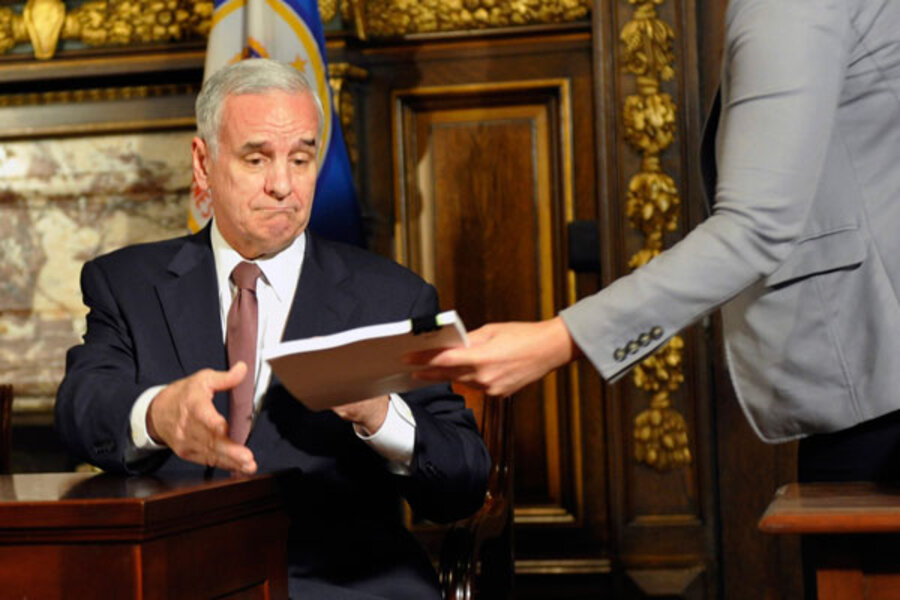Lessons from the Minnesota shutdown: Was it even necessary?
Loading...
| Chicago
Minnesota state government is once again open for business following a series of bills signed into law Wednesday that are designed to eliminate the state’s $5 billion budget deficit.
Despite marking an end to a nearly three-week standoff between Gov. Mark Dayton (D) and Republican lawmakers in both houses, neither side is claiming a direct victory. Governor Dayton told reporters Wednesday he was “not entirely happy” with the budget but referred to it as “the best option that is available.” Similarly, Deputy Majority Leader Geoff Michel referred in a statement to the budget as “not the most ideal to anyone.”
The dissatisfaction on both sides of the aisle points to the broader, national problem of the two parties finding compromise in the aftermath of midterm elections that ushered in many hard-line tea party Republicans. In Minnesota, the impasse suggests that the two state parties need to think twice before shutting down the government to get what they need, experts say.
“This was an accomplishment neither party wants credit for. It’s extraordinary: you have both parties doing what they had to do and not feeling proud of it,” says Larry Jacobs, director of the Center for the Study of Politics and Governance at the University of Minnesota Humphrey Institute of Public Affairs. “We have to find a way to get parties closer to the point where they can find some resolution, even if its far from ideal."
In signing the bill, Dayton abandoned his plan for a tax increase on the state’s wealthiest residents. At the same time, he agreed to the Republican plan of raising $1.4 billion by increasing the amount of deferred school payments and borrowing from future tobacco settlement payments. For Republicans, compromise came from removing all social-issue policy changes from the budget bill and eliminating a 15 percent state workforce cut.
Just because both sides settled on a deal doesn’t mean the bickering will end. The borrowing measures and uncertainty about how much the deficit may grow in coming months means that the fighting is more or less postponed until the 2012 election cycle.
“One lesson from this is politicians, whenever possible, will move hard decisions into the future,” says Kathryn Pearson, a political scientist at the University of Minnesota. The borrowing portion of the bill pushes the burden into the next election, when both sides will frame it to their respective advantage, says Professor Pearson. The unknown factor is the economy; the recovery will determine whether the future borrowing was prudent or not.
“In essence, they’ve set it up for more conflict and more hard decisions,” she says.
The state government shutdown was considered “soft” because many essential services remained open. But if lawmakers agreed to a full shutdown, there is a sense compromise would have arrived sooner than it did.
“The more dramatic and complete the shutdown, the quicker the pain. The pressure builds, which helps push for quicker settlements” between parties, says Charles Franklin, a political scientist at the University of Wisconsin at Madison.
Public outcry against the shutdown was only starting to spark when the deal was reached, as the public started to recognize the economic impact of the loss in services, Professor Franklin says. For some Minnesotans, such as the 22,000 state workers put on furlough, the shutdown had a palpable effect. For others, the shutdown resulted in unexpected inconveniences, such as closed social-service agencies, which became more noticeable as the weeks went on.
One unexpected example: Last week brewer MillerCoors announced it would be forced to remove 39 brands of beer from every restaurant, bar, and liquor store in the state because the state permitting agency was not open to renew its brand label registration.
Franklin says that despite the inconvenience to the public, it’s not likely voters will carry those frustrations to the voting booth in 2012.
“Rarely have state shutdowns led to long-term economic damage to voters within the state. Even when we’ve seen temporarily layoffs, most of those states have restored the pay that was lost. The [Minnesota] shutdown was short enough that the damage is pretty minimal. By the end of the year it will be seen as pretty minor,” he says.
Looking back, voters may recognize that the deal signed into law Wednesday is very similar to the one Dayton rejected during talks June 30, which led to the shutdown. The shutdown might have been avoided if Dayton realized that compromise was unavoidable between the two parties, Professor Jacobs says.
“I think the initial shutdown was not entirely clear as to its consequences, but they became more so when time went on,” Jacobs said. “And all these things start to pile up.”





